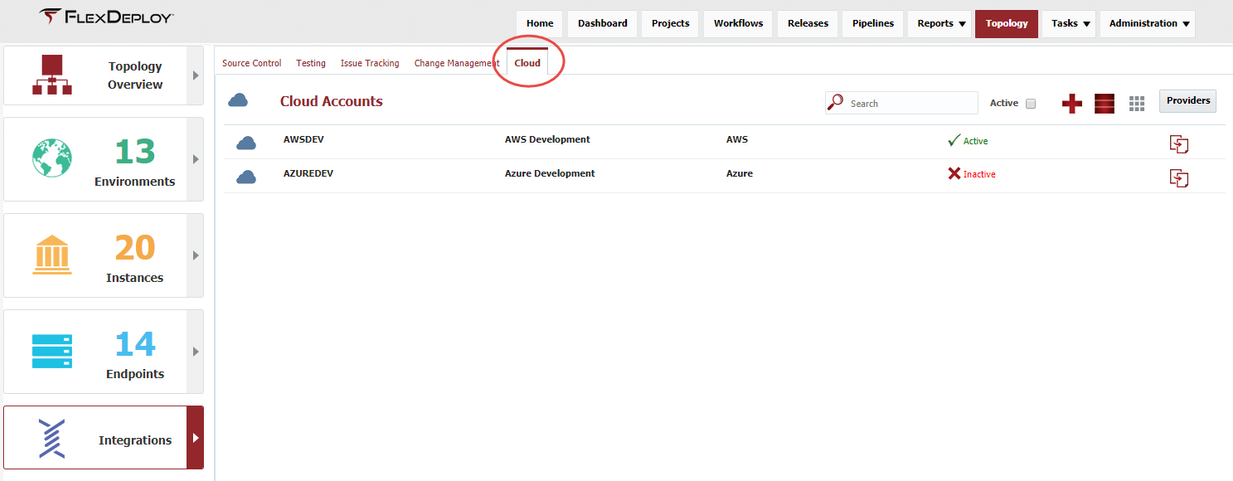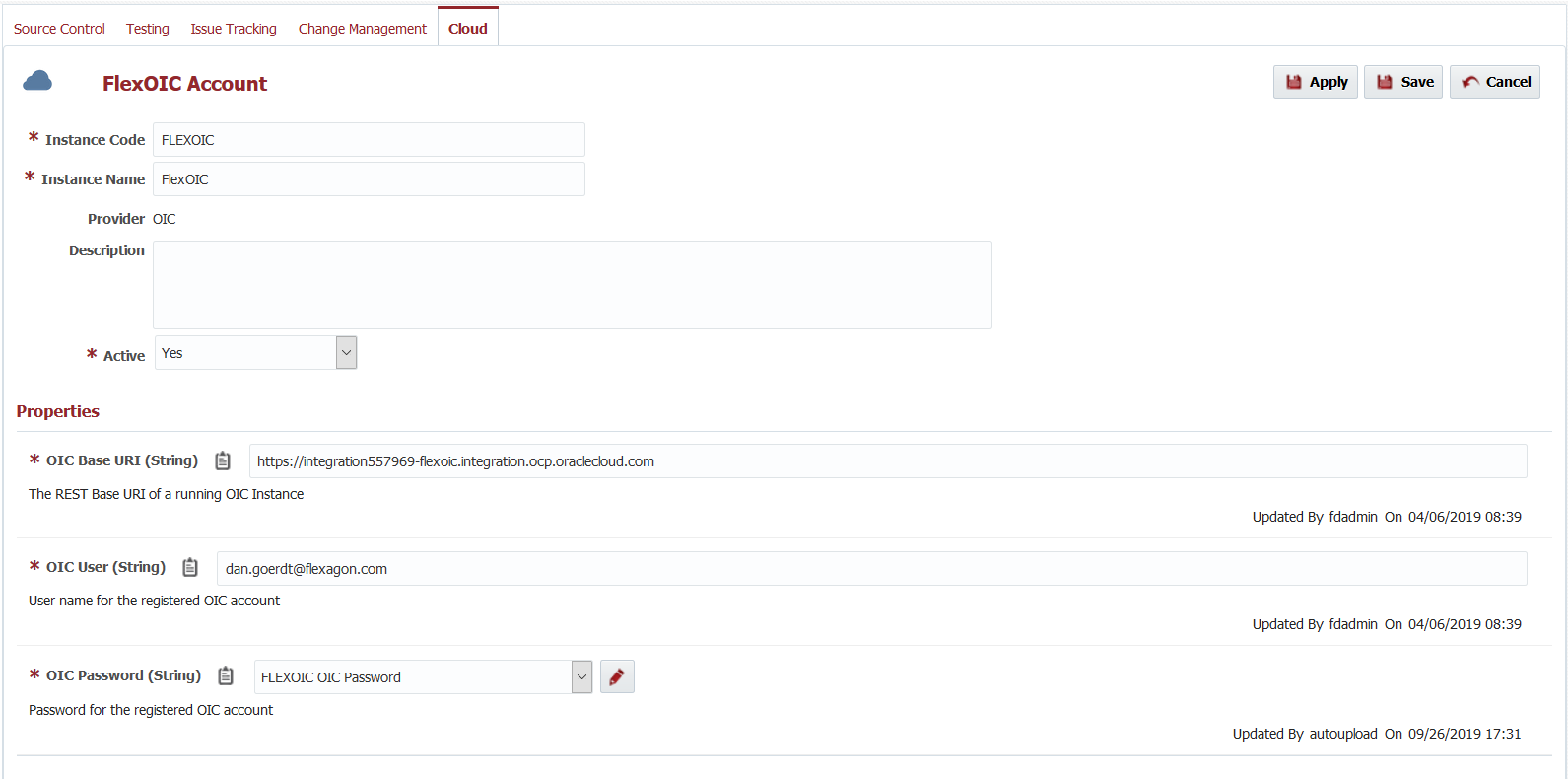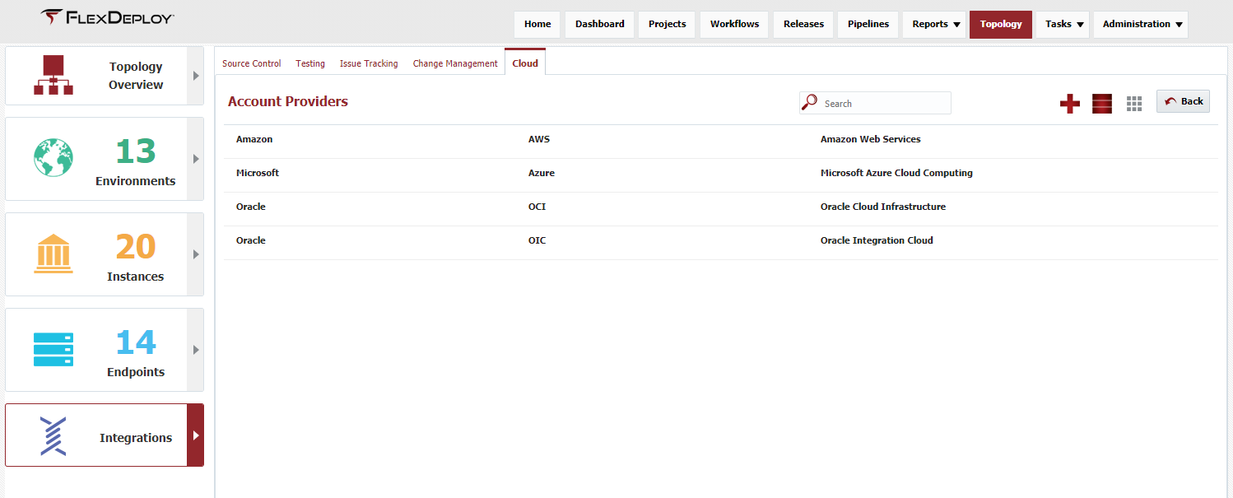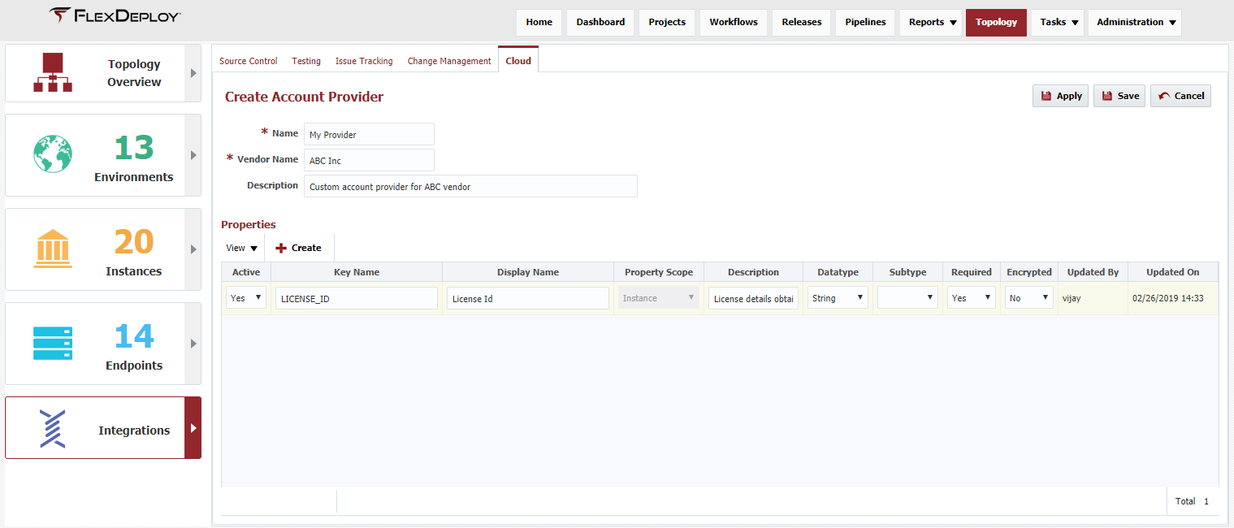Creating/Editing a Cloud Account and Provider
select the Cloud tab for managing the Cloud account providers and accounts.
- Click or to inactivate or activate the cloud account
- Click to clone the specific cloud account
- Click to manage different cloud account providers
To create a new cloud account, Click thebutton. To edit an existing Instance, click on an Instance row from the list.
Enter values for the fields as described in the table below. Click the Save button to save the changes.Optionally click the Apply button to save the changes, but remain on the current screen until the Cancel button is clicked.
Note that encrypted properties are stored in Credential Store (Local or External) and can be configured using Edit button next to credential name drop down. Alternatively, you can reuse single credential for multiple properties also, in which case you should name that credential appropriately.
Field Name | Required | Description |
|---|---|---|
Instance Code | Yes | Short name for the Instance. |
Instance Name | Yes | Long display name for the Instance. |
Provider | Yes | Provider for which the account is created. |
Description | No | A description of the Instance. |
Active | Yes | Whether or not the Instance is active in the system. Defaults to "Yes". |
| Properties | No | If the selected provider has any properties defined, then you must set up values for those properties based on the property key definition. |
Providers
Click to manage different cloud account providers
Out-of-the-box Providers
Apigee, AWS, Azure, OCI, OIC, Salesforce are the FlexDeploy out-of-the-box providers with the default properties.
To create a new cloud account provider, Click thebutton. To edit an existing provider, click on a provider row from the list.
Enter values for the fields as described in the table below. Click the Save button to save the changes.Optionally click the Apply button to save the changes, but remain on the current screen until the Cancel button is clicked.
Field Name | Required | Description |
|---|---|---|
| Name | Yes | Name for the account provider |
| Vendor Name | Yes | Vendor like Amazon, Oracle, Microsoft, Google etc |
Description | No | A description of the provider. |
| Properties | No | Setup one or more property key definitions for the provider which will be used for every account created for this provider. |
Default Provider Properties
Out-of-box account provider property key definition cannot be modified and will always be read-only.
| Provider | Property | Type | Description |
|---|---|---|---|
| Apigee API Platform | Apigee Org Name | String | The org name of the apigee account. |
| Apigee Host URL | String | Apigee Host URL. | |
| Apigee Authentication Type | String | Apigee Authentication Type | |
| Apigee Username | String | The username of the apigee account. | |
| Apigee Password | String | The password of the apigee account. | |
| Apigee Token URL | String | Apigee Token URL. | |
| Apigee MFA Token | String | Apigee Multi Factor Authentication token | |
| Apigee Bearer | String | Apigee Bearer | |
| Apigee Refresh | String | Apigee Refresh | |
| Apigee Client Id | String | Apigee Client Id | |
| Apigee Client Secret Key | String | Apigee Client Secret Key | |
| Amazon Web Services | AWS Access Key | String | The access key found on the "Security Credentials" page of the AWS management console. |
| AWS Secret Key | String | The secret key found on the "Security Credentials" page of the AWS management console. | |
| Microsoft Azure | Username | String | User name for the registered Azure account |
| Password | String | Password for the registered Azure account | |
| Subscription Id | String | The subscription ID is a GUID that uniquely identifies your subscription to use Azure services. | |
| Tenant Id | String | The tenant ID of resource. | |
| Azure Application Client ID | String | The Client ID assigned to Application | |
| Azure Application Client Key | String | The key assigned to Application | |
| Azure Active Directory Domain | String | The domain name of the AAD to access. | |
| Keystore Path | String | The path to the JKS containing the management certificate. | |
| Keystore Password | String | The password for Keystore Path | |
| Azure Environment | String | The name of the environment. | |
| Oracle Cloud Infrastructure | OCI Tenancy Id | String | Select the OCI Tenancy Id to use. |
| OCI User OCID | String | The OCID of the user to connect to OCI as. | |
| OCI Private Key | String | The private key to use for authentication. | |
| OCI Key Fingerprint | String | The fingerprint of the key pair to use for authentication. | |
| OCI Private Key Passphrase | String | The passphrase of the private key to use for authentication. | |
| OCI Region | String | The region your OCI instance exists in. This is an optional property primarily used for Terraform. | |
| Oracle Integration Cloud | OIC User | String | User name for the registered OIC account |
| OIC Password | String | Password for the registered OIC account | |
| OIC Base URI | String | The REST Base URI of a running OIC Instance | |
| Salesforce | User Name | String | Authentication User Email Id for Salesforce. You can either User Id and Password combination to login or User Id with Server Key file and Client Id. |
| JWT Key File | String | Path to a file containing the private key | |
| Password | String | Salesforce password and security token for Salesforce User. Please Note: Password and API Security token without any spaces or any other separator / delimiter. | |
| Client ID | String | OAuth client ID (also called the consumer key) | |
| Salesforce Org Type | String | Enter Org type for Development Environment. Eg: Sandbox or DevHub or Developer | |
| Salesforce URL | String | The login URL of the instance the org lives on | |
| Sandbox Name | String | Name of the Sandbox to access |
Creating New Property
- New property cannot be added for the out-of-box default providers. New property can only be added for the custom providers.
- Click to add new custom property for the custom provider property set
- When adding and saving new property to the custom account provider property set,
- If the custom account provider already has one or more accounts existing
- New property will NOT be added to the existing account automatically. It will be added for update when editing the account.
- If the custom account provider does not have any accounts
- New property will be added to the account when it is created.
- If the custom account provider already has one or more accounts existing
Editing Existing Property
- The out-of-box default properties for the providers will always be read-only.
- Custom property key definitions can only be updated.
- Property can not be deleted. It can either be activated or inactivated only.
- Properties updated on the account provider property set will be synced up for any existing account only when the respective account is edited.
Related content
- style









